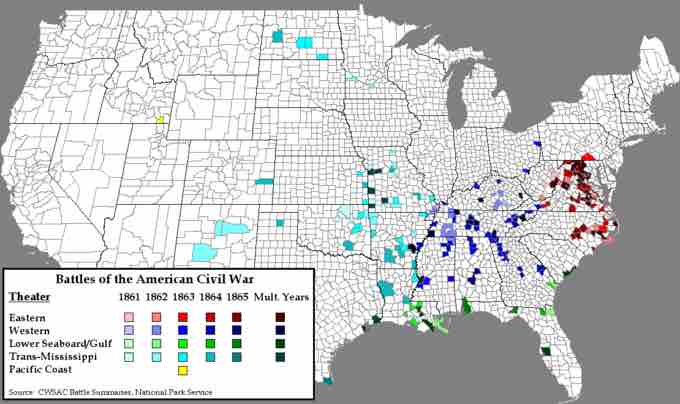More than 10,000 military engagements took place during the Civil War. The battles of the American Civil War were fought between April 12, 1861, and May 13, 1865, in 23 states and in the District of Columbia, as well as in Arizona Territory, Colorado Territory, Dakota Territory, Indian Territory, New Mexico Territory, and Washington Territory, and included various naval engagements. The major engagements can be divided into the eastern theater, including Gettysburg and Antietam, and the western theater, including the Battles of Shiloh and Vicksburg. Smaller theaters included the Trans-Mississippi theater, the Pacific coast theater, and the lower seaboard theater, which included Texas.

Battles of the American Civil War
A color-coded map of the battles of the American Civil War.
Fort Monroe in Virginia; Fort Sumter in South Carolina; and Fort Pickens, Fort Jefferson, and Fort Taylor, all in Florida, were the remaining Union-held forts in the Confederacy, and Lincoln was determined to hold them all. Under orders from Confederate President Jefferson Davis, troops controlled by the Confederate government bombarded Fort Sumter on April 12, forcing its capitulation. Most Northerners rallied behind Lincoln's call for all states to send troops to recapture the forts and to preserve the Union. Tennessee, Arkansas, North Carolina, and Virginia, however, refused to send forces against their neighbors, declared their secession, and joined the Confederacy.
Winfield Scott, the commanding general of the U.S. Army, devised the Anaconda Plan to win the war with as little bloodshed as possible. His idea was that a Union blockade of the main ports would weaken the Confederate economy and the capture of the Mississippi River would split the South. Lincoln adopted the plan, but overruled Scott's warnings that his new army was not ready for an offensive operation in order to satisfy public demand for an immediate attack.
While the Confederate forces had numerous successes in the eastern theater of the American Civil War, they were defeated many times in the West. They were driven from Missouri early in the war as a result of the Battle of Pea Ridge. The Confederate invasion of Columbus, Kentucky, ended Kentucky's policy of neutrality and turned that state against the Confederacy. Nashville and central Tennessee fell to the Union early in 1862, leading to attrition of local food supplies and livestock and a breakdown in social organization. The one clear Confederate victory in the West was the Battle of Chickamauga. General Braxton Bragg defeated Union troops, who retreated to Chattanooga, which Bragg then besieged.
The Union's key strategist and tactician in the West was Ulysses S. Grant, who won victories at Forts Henry and Donelson, the Battle of Shiloh, and the Battle of Vicksburg, which cemented Union control of the Mississippi River and is considered one of the turning points of the war. Grant marched to the relief of troops in Chattanooga and defeated Bragg at the Third Battle of Chattanooga, driving Confederate forces out of Tennessee and opening a route to Atlanta and the heart of the Confederacy.
Guerrilla activity turned much of Missouri into a battleground. Missouri had, in total, the third-most battles of any state during the war. The other states of the West, though geographically isolated from the battles to the east, saw numerous small scale military actions. Battles in the region served to secure Missouri, Indian Territory, and New Mexico Territory for the Union. Confederate incursions into New Mexico territory were repulsed in 1862, and a Union campaign to secure Indian Territory succeeded in 1863. Late in the war, the Union's Red River Campaign was a failure. Texas remained in Confederate hands throughout the war, but was cut off from the rest of the Confederacy after the capture of Vicksburg in 1863 gave the Union control of the Mississippi River.
At the beginning of 1864, Lincoln made Grant commander of all Union armies. Grant made his headquarters with the Army of the Potomac and put Major General William Tecumseh Sherman in command of most of the western armies. Grant understood the concept of total war and believed, along with Lincoln and Sherman, that only the utter defeat of Confederate forces and their economic base would end the war. This was total war, not in terms of killing civilians, but rather, in terms of destroying homes, farms, and railroads. Union forces in the East attempted to maneuver past Lee and fought several battles during that phase of the eastern campaign, sometimes termed Grant's Overland Campaign.